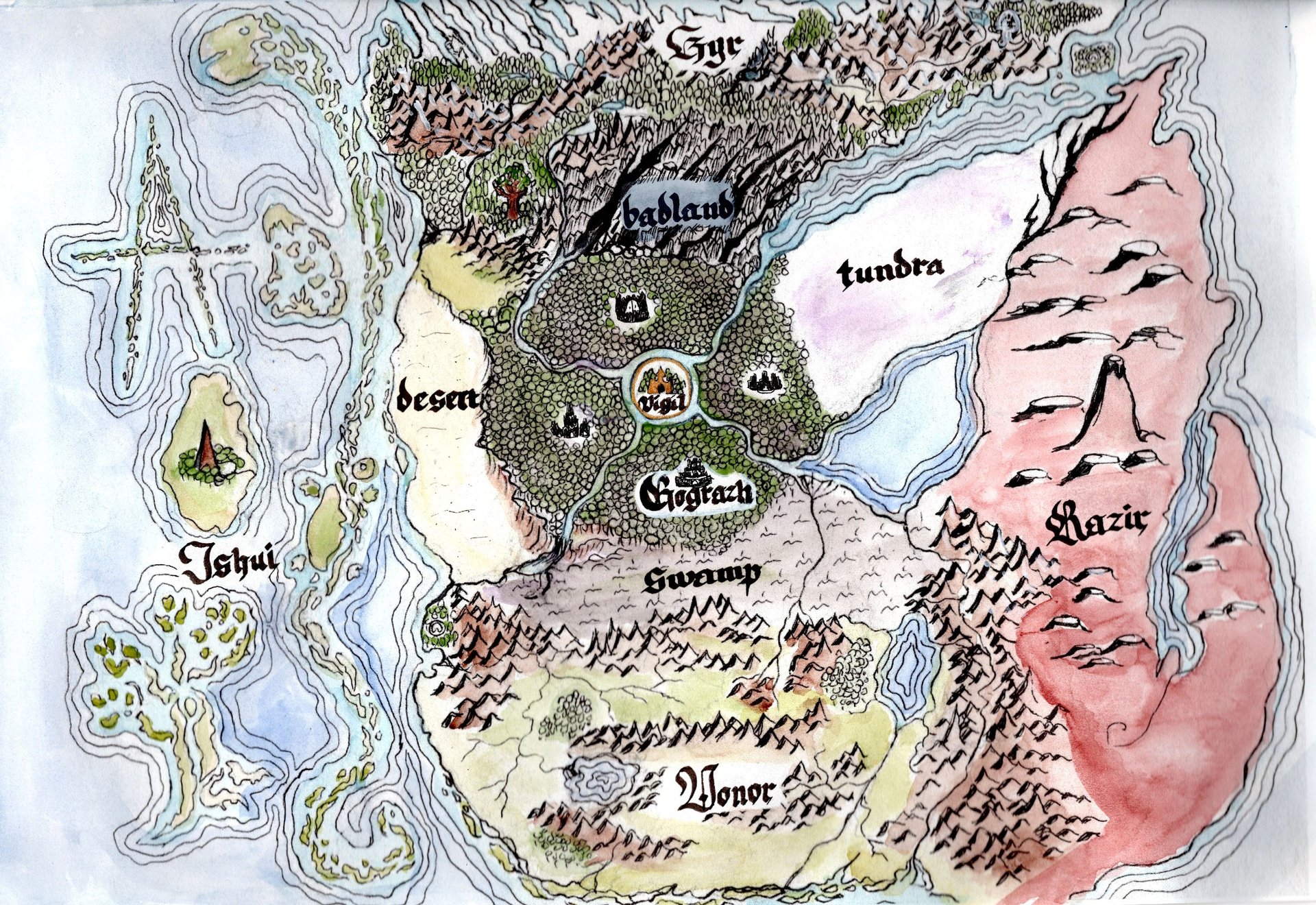
Gograzh



Most of Gograzh is a thick, tangled jungle. On the edges, along the borders of the other nations, Gograzh reaches out tendrils like a hungry amoeba seeking to devour everything in reach.
Traversing through any part of Gograzh is a dangerous, grueling endeavor. Compasses do not work anywhere within it, and the sky is always obscured by a shadowy haze, which makes navigation by the sun or stars impossible. To make matters worse, time and space behave strangely. Those who lose their way are often surprised by how much time has passed - months or even years - when to them it felt like only a couple hours. It is not just the residents of Gograzh, but the very land itself that seems to greedily steal all that it can - including time.
Rough maps exist that warn of specific dangers, but humans know not to rely on these maps as none of them are detailed enough to chart an expedition. The only way humans can navigate Gograzh is with the help of someone who has a Soul Bond to Light, which most often means an Orani. A human with a Bond to Light can always sense the direction of the Font of Light's foundation. Cartographers and way finders use this as the only cardinal direction within Gograzh, allowing daring adventurers to make their way to the ruins of ancient Ora - and to the Citadel within those ruins.
There are very few, if any, natural animals as they have been twisted into aberrations. Most sentient Gograzhi are formed from the Kal'inokh magic some wield and dissipate into Essence when they are slain. Others were once humans, perverted into something foul or raised against the natural order as Undead. Then there are older, stranger beings who lurk in the shadows. Not all of them are blatantly malevolent or antagonistic to humans, and some may even be willing to offer assistance…for the right price.




Regions of Gograzh
Central Gograzh
The land that was once Ora makes up the central area of Gograzh. What was once a beautiful forest thrumming with life is now a tangled jungle. The already muted light from the haze filled sky is blocked entirely by the jungle's canopy. It is like traversing within an enormous cavern. Thick, knotted vines hang from the higher branches and creep along the ground. Despite the lack of sunlight, a dense, thorny underbrush has developed - strange plants that cringe away from any light source and wither when exposed to sunlight. Pathways exist, but they rarely stay accessible for long, like a shifting labyrinth.
The climate within is fickle, but always wet. It shifts between hot and cold with no apparent rhythm. To travelers, the shift to cold after enduring the suffocating heat feels like a boon - until the humidity in the air begins to freeze and they find themselves battling frostbite. Travelers report an ever-present feeling of being watched, which adds to the already oppressive atmosphere.
North Gograzh
The north area of Gograzh has expanded into Kyr's ancestral territory. The jungle breaks abruptly into a sun scorched, rocky wasteland. Earthquakes are frequent, and huge canyons, caverns, and crevices scar the landscape alongside sharp spire mountains and cliffsides. Ash and toxic fumes belch from numerous cracks, choking and stifling any natural plant or animal life before it can grow. On the rare stretches of flat land, bright, turquoise pools ringed with vibrant yellows and reds tempt travelers with their beauty. However, the steam rising from them is pure poison, and even a brief dip within could melt the flesh from your bones.
Even at the top of the peaks the air is humid and stagnant. But experienced travelers know that feeling a breeze would be far worse as it would signal the beginning of one of North Gograzh's sudden, violent storms. The howling winds are strong enough to trigger avalanches and often form tornadoes, and the acid rain can cause severe burns.
East Gograzh
Eastern Gograzh reaches into Razir. Much like in the north, the jungle abruptly ends, but in the east it transitions into a harsh tundra. Thick ice, in places hundreds of feet deep, covers the ground. Although snow drifts do exist, the near constant, driving winds sheer away most snow, leaving behind extremely slick, treacherous ice.
Even in the hottest part of the year, it barely rises above freezing temperatures. However, this is just enough heat to allow the ice to shift as it melts, creating artificial mountains, valleys, cliffs, and ravines. What might have been a safe route to travel one year may be impossible to traverse the next. Whiteouts - blinding blizzards - are common.
South Gograzh
To the south, the water levels rise, turning the jungle of central Gograzh into a swamp. What little ground visible above the water is thick mud or, if you're unlucky, quicksand. The murky waters are mostly stagnant and coated with slimy algae. The water levels vary so much, and often so abruptly, that wading through on foot is not advised. Instead, travelers use canoes, but navigating through the gnarled trees, varying water levels, and frequently thick fog is a challenge.
Further south, it transitions into marshes and bogs, which have their own dangers. The marshlands have many pockets of pluff mud - light brown, gooey, soft mud that cannot support any weight. A creature that steps on it will immediately sink to their waist or deeper. Likewise, the bogs have areas that appear safe to walk upon, but upon breaking through the thin layer of peat, the pressure can easily suck you under.
A rocky mountain range marks the current southern edge of Gograzhi territory. The mountains have prevented the slow creep of the swamplands, but they haven't stopped Grograzhi from building strongholds among the peaks.
West Gograzh
To the west, the Gograzhi jungle halts at the edge of a cliff and the land plummets nearly half a mile. The land beyond the cliff is an arid desert. A tremendous dune sea dominates the southern region, and, with no plant life or water sources, travelers find no respite from the dry heat among its shifting sands. Further north, the large dunes flatten into a rockier desert. Although temperatures at the height of summer may be quite high, most of the year it stays fairly moderate. However, the extreme temperature fluctuations between day and night and the lack of any water sources make traveling through the region very difficult.
The ocean and coast are frequently enveloped by a thick fog that rolls in from the sea each morning only to evaporate by midday. Even many miles offshore, the currents are strong and unpredictable. Between the currents and impenetrable fog, only the most skilled sailors - or the most foolhardy - dare to navigate along this area of the coast. Remnants of scores of shipwrecks have been discovered. Some wreckage has even been found hundreds of feet inland, and scholars puzzle over how that may have occurred.










